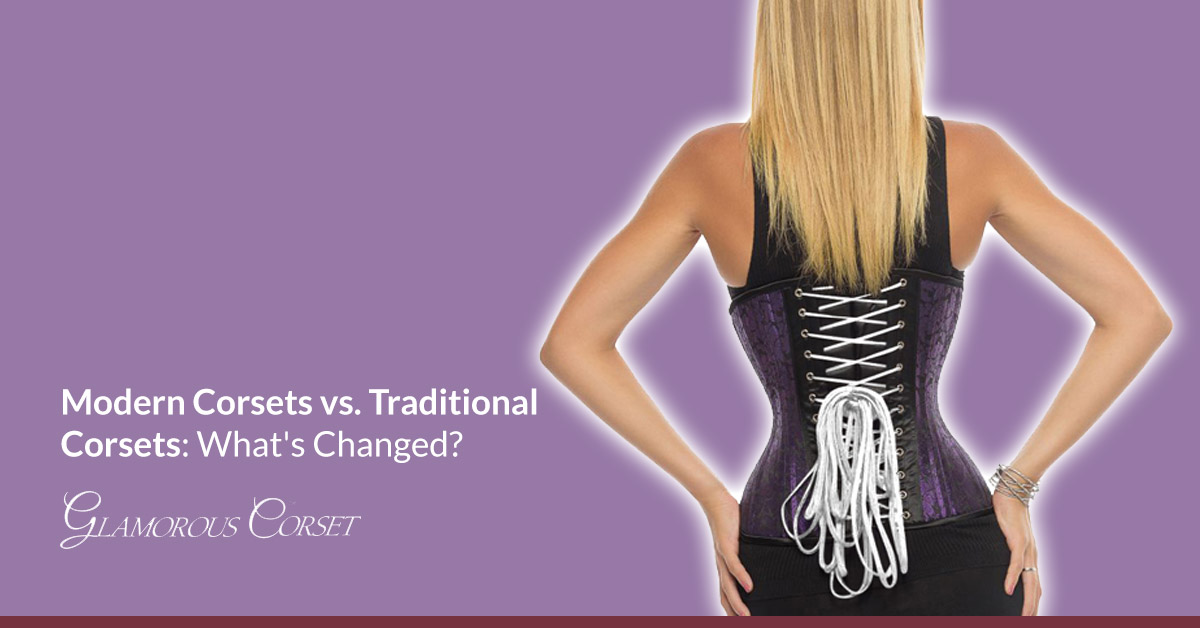Blog
Modern Corsets vs. Traditional Corsets: What’s Changed?
Corsetry has traditionally served as an undergarment, not to mention a taboo topic of discussion. These compression garments, meant to corral a lady’s curves into feminine proportions for the sake of supporting a certain style of dress (notably, Victorian), quickly became the stuff of male fantasy. Although women of the Victorian era viewed corsets as largely functional, and lived full and active lives while wearing them, the male gaze naturally turned them into an object of fetish, a sometimes-unfortunate interpretation that lives on today.
When it comes to modern corsets vs. traditional corsets, however, there have been some changes, both practical and societal. While any undergarment seems to hold some level of titillation for the puritanical mind, and indeed, corsets remain popular as items of bedroom play, modern women are choosing corsets for a range of purely functional reasons, and the market for corsetry has advanced in a variety of ways to accommodate. Here are just a few ways modern corsets have changed to serve the needs of consumers.
A Bone of Contention
Perhaps the biggest change over the years has been to the boning that delivers this garment’s necessary strength and rigidity. Once upon a time, the ideal boning material was baleen, also known as whalebone (hence the term “boning”). In fact, baleen is not bone. It’s actually a rigid, yet flexible keratinous material (similar to human fingernails or horse’s hooves) found in the mouth of baleen whales.
By the early part of the 20th century, modern steel replaced baleen as a cheaper, more readily available material that wouldn’t dry out and break under pressure. Later on, societal views toward the harvesting of baleen also shifted, so that today, legal baleen sales in the U.S. are restricted to Alaskan Natives offering authentic native articles of handcraft. Luckily, steel boning is superior to the baleen boning of old, in every possible way.
Textile Transformation
Another dramatic shift in corsetry came with the textile revolution that made a wider range of cloth available to the general public. Corsets of old were most often made with sturdy cotton or linen stiffened with starch, while more decorative garments might be made from satin or silk.
While these fabrics are still used today, they are much more readily available, and options like cotton coutil (a twill created for corsetry), satin, silk brocade, velvet, breathable mesh, and even leather (or faux leather) are easy to find. This ensures that every wearer has access to a diverse array of corset types suitable for any outfit or occasion.
Bras of Another Breed
As early as the 19th century, bra-like garments began to appear as corset substitutes, although they were often still attached to underbust corsets. It wasn’t until the early 20th century that the modern brassiere was invented by Mary Phelps Jacobs, a well-endowed woman seeking a better way to wear popular clothing trends of the time, which didn’t work well with corsetry.
This shift naturally impacted the corset market, and it wasn’t long before many women had shed their constricting corsets in favor of more versatile brassieres. Throughout the 20th century, corsets developed a reputation as torture devices devised by a patriarchy intent on hobbling women. In truth, women of the Victorian era wore them for much the same reason many modern women choose to: in order to slim the waist, create an hourglass figure, and look better in clothing.
Today, women have a choice about the undergarments they wear. Those interested in waist training have plenty of options, from overbust corsets that eliminate the need for a bra, to underbust models that may be easier to stealth when paired with a brassiere. With so may sizes, shapes, materials, and embellishments to choose from, women can get the most out of modern corsets.
Benefits of Modern Corsets vs. Traditional Corsets, Beyond Aesthetic Appeal
Although corsets were a largely functional affair, once upon a time, modern corsetry has opened the door to a range of benefits for wearers. In addition to creating a flattering figure under clothing, corsets can also be worn on full display as fashion accessories. Some corset wearers engage in waist training, while others use them to correct posture, alleviate back pain, or spice up intimate encounters. Whatever your reason for donning a corset, you’ll find that this modern garment offers endless options for customization, and imparts several benefits you probably never expected.
To stay up-to-date with weekly blog posts, waist training tips, and the chance to win one of our monthly corset giveaways, follow us on Facebook, Instagram & subscribe to our mailing list today! Want to find the perfect steel boned corset? Shop some of our favorites: underbust corsets, overbust corsets, corset dresses. You can also shop our corsets by material: cotton corsets, denim corsets, leather corsets, mesh corsets, pvc corsets, and satin corsets. Have questions about getting started with waist training or finding the right size corset? Contact us!

My name is Rachel, I am the owner of Glamorous Corset, a small business founded by me in 2010. Back In 2005, I was in a car accident that left me with a herniated disk. Much to my surprise I learned steel boned corsets were beneficial to several medical injuries including mine. I was always intrigued with corsetry, their history and their beautiful aesthetic. I love sharing knowledge about corsets, educating my wonderful readers and breaking the negative stigma related to corsetry. In combination with my years of research and personal experience I hope my articles are useful and can help anyone who has struggled with some of the same things I have. More about me…


